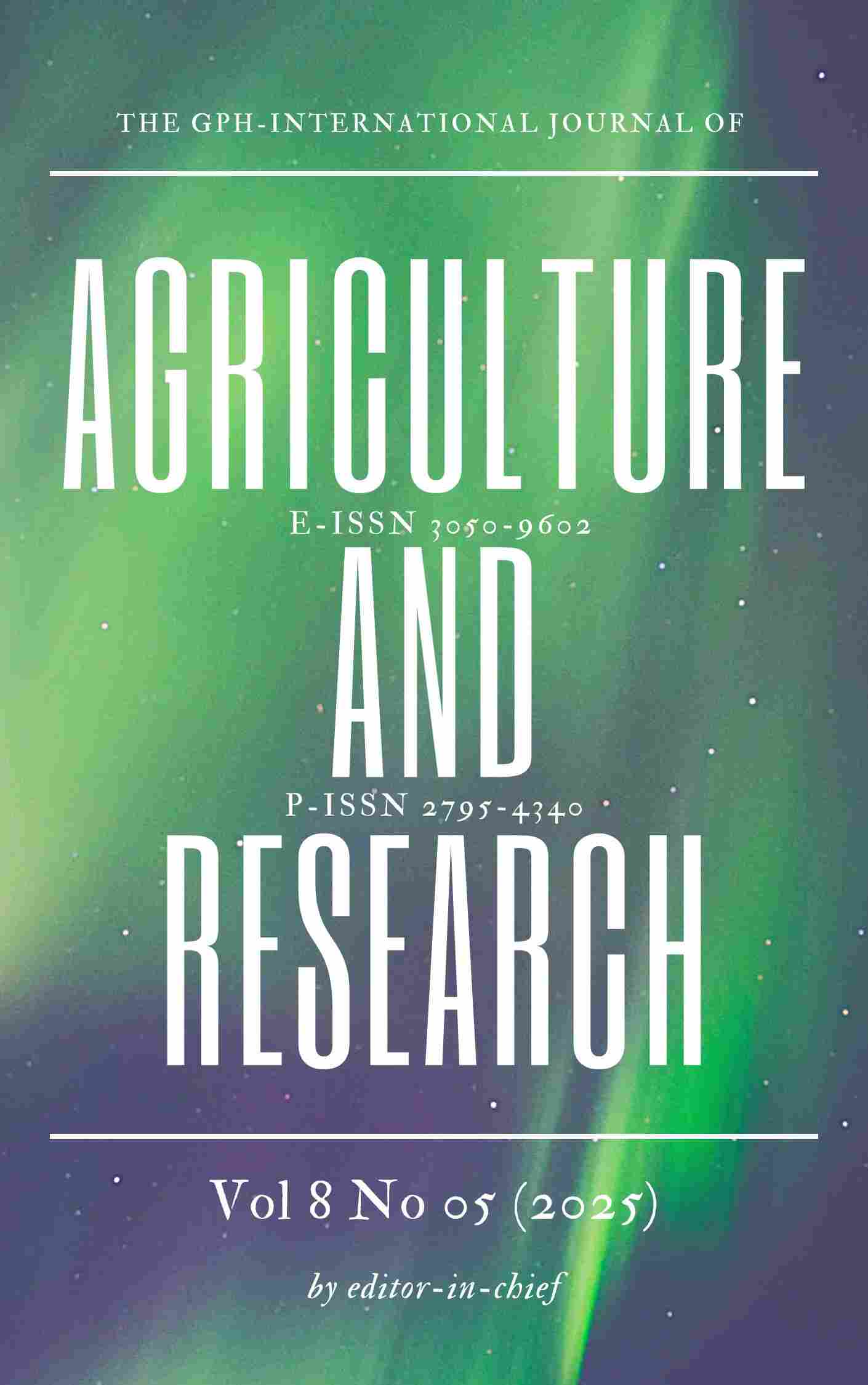Effect of using the Local Concentrate as an alternative to the imported concentrate on the performance and egg quality of layers
Abstract
A total of 27 White Hisex layer hens (24 weeks old) were used in this study. They were purchased from a company specializing in the production of laying hens. The birds were randomly divided into three treatment groups (A, B, and C), with each group further subdivided into three replicates of three birds each. Group A was fed a diet containing 5% local concentrate, Group B received 7.5% local concentrate, while Group C (control) was fed a diet with 5% imported concentrate. The inclusion of local concentrate at both levels significantly improved egg production and quality parameters compared to the control group. The results revealed that replacing imported concentrate with local concentrate had a significant effect on egg production, egg mass, and egg number, but not on egg weight. Regarding egg quality characteristics, no significant differences were observed in shape index, egg diameter, Haugh unit, shell weight, yolk weight, or albumen weight—except for egg height and yolk color, which showed significant differences (p ≤ 0.05) among treatment groups. Economic evaluation indicated that replacing imported concentrate with local concentrate at both levels was more cost-effective than the control. The 7.5% local concentrate level proved to be the most economically beneficial. Based on the findings, locally formulated concentrate can be considered a viable alternative to imported concentrate in layer diets, without adverse effects on performance or egg quality.
Downloads
References
Al – Daraji, H.J., Razuki, W.M., Al-Mashadani, H.A., Mirza, H.A., Al – Hayani,
W.K and Al – Hassani, A.S. (2011). Influence of source of oil added to diet on egg quality traits of laying quail. Intl. J. Poultry Sci. 10: 130-136.
AOAC. Association of Official Analytical Chemists. In: Williams S, editor. Official methods of analysis. 14th ed. Washington: AOAC; 1984. 1018 pp.
Bonekamp R.P.R.T.,Lemme A., Wijtten P.J.A. and Sparla J.K.W.M. (2010). Effects of amino acids on egg number and egg mass of brown (heavy breed) and white (light breed) laying hens. Poult. Sci. 89, 522-529.
Acta Scientiarum. Animal Sciences, 31(1), 13-18.
Duncan, D. B. (1955).Multiple range and multiple F tests: Biometrics, 11:1- 42.
Ellis N. (1981). The nutrient composition of Sudanese animal feeds. Bulletin 1: Northern Central Sudan. Central Animal Nutrition Research Laboratory, Kuku, Khartoum, Sudan.
Fakhraei J., Loutfollahian H., Shivazad M., Chamani M. and Hoseini S.A. (2010). Reevaluation of lysine requirement based on performance responses in broiler breeder hens. African J. Agric. Res. 5(16), 2137-2142.
Gous R.M. and Nonis M.K. (2010). Modeling egg production and nutrient responses in broiler breeder hens. J. Agri. Sci. 148, 287-301.
Gunawardana, P., D. A. Roland Sr., and M. M. Bryant. 2008. Effect of energy and protein on performance, egg components, egg solids, egg quality, and profits in molted Hy-Line W-36 hens. J. Appl. Poult. Res. 17:432–439.
Hanna, A. C. S., Cruz, F. G. G., Rufino, J. P. F., Tanaka, E. S., Chagas, E. O., & Melo, J. B. S. (2013). Bioefficacy of the Copaiba Oil (Copaifera sp.) In Diets
of Laying Hens in the Second Production Cycle in Humid Tropical Climate.
International Journal of Poultry Science, 12(11), 647-652.
Hazim J. Al-Daraji H.A., Al-Mashadani H.A., Mirza W.K., AlHayani A. and Al- Hassani S. (2011). Influence of source of oil added to diet on egg quality traits of laying quail. Int. J. Poult.Sci. 10, 130-136.
Kjos, N.P., Herstad, O., Skrede, A. and Overland, M. (2001). Effects of dietary fish silage and fish fat on performance and egg quality of laying hens. Can. J. Anim. Sci. 81: 245 - 251.
Mukhtar M.A.; Mohammed K.A. and Musa. M.H. (2010).Replacement Value of Lysine and Methionine for Super Concentrate in Broiler Chick’s Yield and Quality. Journal of Science and Technology, 11(2):27-29.
NRC. 1994. Nutrient Requirements of Poultry. 9th rev. ed. Natl. Acad. Press, Washington, DC.
Park Jae H. and Kyeong S.R. (2011). Relationship between dietary protein and Betaine supplementation in laying hens. Japan Poult. Sci. Assoc. 48, 217-222.
Rao S.V., Rama V., Ravindran T., Srilatha A.K., Panda M.V. and Raju L.N. (2011). Effect of dietary concentrations of energy, crude protein, lysine and methionine on the performance of White Leghorn layers in the tropics. J. Appl. Poult. Res. 20,528-541.
Rose, M. E., Orlans, E. and Buttress, N. (1974). Immunoglobulin classes on the hen’s egg, their segregation in yolk and white. Europe Journal Immunology. (4):521–523.
Rowghani, E., A. D. Boostani, H. R. Mahmoodian Fard and R. Frouzani, 2007. Effect of Dietary Fish Meal on Production Performance and Cholesterol Content of Laying Hens. Pakistan Journal of Biological Sciences, 10: 1747-1750.
Seham A. Khalid*, Mahgoub G Elhag, Eiman H. Elshareef, Sawsan M. Ahmed, Lila D. Musa. (2015).; comparison between local and imported commercial concentrates on the performance of broiler chicks. Sudanese Journal of Agricultural Sciences 2, 16–21.
Sohail S.S., Bryant M.M. and Roland D.A. (2003). Partial explanation for difference in response of hens fed diets formulated based on lysine vs. protein. J. Poult. Sci. 2(5), 345-350.
Stadelman, W.J., O.J. Cotterill, 1977: Egg Science and Technology. AVI Pub. Co. Westport. CT., USA.
Tanuja, A. Kumar , (2017 ) .Effect of dietary supplementation of acid ensiled fish waste on production performance, egg quality and serum biochemistry in layer Japanese quail (Coturnix coturnix japonica),Agricultural Research Communication Centre , Indian J. Anim. Res., 52(5) 740-743.
Uma N. (2000). Use of soybean meal in layer chicken diets. Ph D. Thesis. Govind Ballabh Pant Univ.Agriculture and Tech. Pant agar, India.
Author(s) and co-author(s) jointly and severally represent and warrant that the Article is original with the author(s) and does not infringe any copyright or violate any other right of any third parties, and that the Article has not been published elsewhere. Author(s) agree to the terms that the GPH Journal will have the full right to remove the published article on any misconduct found in the published article.

























